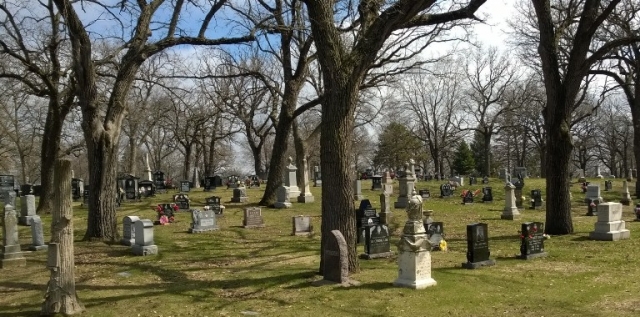CEMETERIES
If they’re not simply abandoned, they are accused of wastefulness and pollution: cemeteries have a hard life in our current times. And yet, they can play an essential role — on both the environmental and human levels — for those who are still living.
The only time I’ve ever slept in a cemetery was in 2018, in Vermont. I’d had a long day of biking and it was starting to get dark; the cemetery was the only place I could find to set up my tent. I tucked myself into a corner near the tomb of a woman whose husband was still alive, according to her epitaph. I spoke to her a little, and in the morning I thanked her for letting me spend the night undisturbed.
Most of my memories of cemeteries are linked to travels: visits to iconic sites such as Père Lachaise in Paris, or Recoleta in Buenos Aires, as well as the rural cemeteries that pop up unexpectedly on country roads. My grandparents are buried in the cemetery in their village, 400 km from where I live. I don’t go to see them often enough, and I’m not alone in this: according to a recent French study, 83 per cent of adults aged 40 and older don’t visit a cemetery more than 10 times per year.
Dying In The Olden Days
 It might go without saying, but for as long as humans have lived, we have also died. Our answers to the question of what to do with our earthly remains have evolved alongside religions and beliefs. Prehistoric humans buried their dead, sometimes with weapons or animal heads to offer some protection — against wild beasts, perhaps, or spirits — in the beyond. Some placed cadavers on mountaintops instead, trusting the elements, and scavengers, to scatter them (this practice persists in Tibet and in some parts of China and India). The first architect, the Egyptian Imhotep, is known for his mortuary constructions. Methods of interment have changed throughout the ages.
It might go without saying, but for as long as humans have lived, we have also died. Our answers to the question of what to do with our earthly remains have evolved alongside religions and beliefs. Prehistoric humans buried their dead, sometimes with weapons or animal heads to offer some protection — against wild beasts, perhaps, or spirits — in the beyond. Some placed cadavers on mountaintops instead, trusting the elements, and scavengers, to scatter them (this practice persists in Tibet and in some parts of China and India). The first architect, the Egyptian Imhotep, is known for his mortuary constructions. Methods of interment have changed throughout the ages.
On the other side of the Mediterranean, the Romans forbade funerary monuments in cities for reasons of hygiene; these were built instead along access roads. The necessity of burying the dead at a distance from the living was, in fact, written in their laws. This knowledge was unfortunately lost in the Middle Ages: in the countryside, the most affluent residents paid local churches in exchange for a tomb inside the building, beneath the flagstones. Poor people had to content themselves with a burial in consecrated ground in the back garden. Over time, all religious buildings came to possess a funerary space, which often functioned as a sort of park (before the time of public parks) where public writers, circus artists, and sex workers rubbed shoulders.
Then came a cloud on the horizon: the plague. With the mass deaths caused by successive epidemics, people were forced to bury victims, draped in a simple winding sheet or shroud, in common graves that were not covered over until they were well filled. These graves sometimes contained as many as 3,000 bodies. The practice gave rise to a series of macabre incidents: a wall that crumbled, sending dozens of dead bodies into the basements of houses and neighbouring streets; a flood that caused half-decomposed corpses to rise to the surface again. And of course, all of this was accompanied by putrid odours . . . It was time to move funerary spaces out of city centres. But it took until the middle of the 19th century for this idea to really take off.
 In North America, the first modern cemetery — Mount Auburn — opened in Cambridge, Massachusetts, in 1831.
In North America, the first modern cemetery — Mount Auburn — opened in Cambridge, Massachusetts, in 1831.
n these gardens outside the city, people from all corners of society came to take a stroll, to tour the grounds in a carriage, to hunt, or to tend the plot of land dedicated to their family. It was an occasion for the richest to flaunt their opulence, importing exotic plants from all over the world.
Designed according to the principles of an English garden, with lawns bordered by asymmetrical flower beds, these cemeteries were sources of inspiration for the first public parks in the United States. New York’s famous Central Park, designed by Frederick Law Olmsted, is a direct descendant of rural spaces like Mount Auburn.
As cemeteries began to multiply, habits, once again, had to change. In 1874 Queen Victoria’s Royal Surgeon published a book in which he promoted the practice of cremation for reasons of public health. As the population increased, he argued, the risks of catching disease mounted as well. Yet it wasn’t until the 1980s that cremation became truly popular. In Canada in 2018 approximately 72 per cent of deaths resulted in cremation. There are many reasons for this: it’s less costly, simpler to organize, and provides an alternative to the uncomfortable logistics of displaying a body at a funeral.
It’s not unusual nowadays to see urns resting upon mantelpieces, if departed loved ones’ ashes haven’t simply been scattered in a meaningful place. The cemetery has lost its nobility.
Full Of Life . . . And Pollutants
“The heydey of cemeteries was in the 19th century, at a time when it represented a point of pride for a family to have a tomb,” says Julien Des Ormeaux, a grave digger I spoke with last winter. We were in the Notre-Dame-des-Neiges Cemetery in Montréal, which opened in 1855. All around us, the tombstones were covered in a blanket of white. Various prominent figures from the city’s history can be found in this monumental place, the largest burial site in the country — from René Angélil, Céline Dion’s husband, to feminist activist and politician Thérèse Casgrain and poet Émile Nelligan.
Inside Julien’s pickup truck with the heat on full blast, I could feel my extremities begin to thaw. “There used to be wolves here,” he said between expert manoeuvres along the narrow, snow-covered paths. This image set me to dreaming.
It turns out that cemeteries are major sites for the preservation of biodiversity. In 2019 a team discovered a whole new species of insect in the Green-Wood Cemetery, right in the heart of Brooklyn.
That same year a meta-analysis identified 140 biological taxa across the world whose preservation is directly linked to burial sites. In 2015 a team found a handful of rare orchids in Turkish cemeteries; researchers in Bangladesh in 2008 discovered medicinal plants. And research on the subject is only just beginning.
One thing is certain: cemeteries can play an essential role in hosting ecosystems. Yet they also get a bad environmental rap, and not without good reason. According to a study published in the Berkeley Planning Journal, funerals use enough wood to build 4.5 million houses each year. Two thousand seven hundred tons of copper and bronze are buried annually, along with 104,272 tons of steel and 1.6 million hectares of forest. Maintaining the manicured appearances of traditional cemeteries, with their perfectly tended lawns, requires gallons of fertilizer and hours of lawn mower use.
Embalming is another practice to re-examine. During the American Civil War, some wealthy families paid to return the bodies of soldiers who died in combat. At the time, though, it was impossible to refrigerate the corpse, which meant that it sometimes arrived at its destination in an advanced state of decomposition. Here’s where embalmers entered the scene, replacing the blood (sometimes in rudimentary fashion) with a mix of mercury and arsenic, which was eventually replaced by formaldehyde. The practice was popularized after the death of Abraham Lincoln in 1865 — so much so that still today, Americans are buried with 19.5 million litres of embalming fluids each year, including 3.8 million litres of formaldehyde, methanol, and benzene.
Little is known about the effect of these pollutants on soils, according to Gilles Bronchti, the director of the Department of Anatomy at the Université du Québec à Trois-Rivières. “Embalming slows decomposition, just like placing a corpse in a coffin. Since the body doesn’t decompose, it has very little impact on the environment in which it is placed.” Although in this context the consequences are difficult to measure, embalming products are still harmful to the environment, he concedes. We can point to the processes behind their production, or to the fact that some of them end up in the sewers. At least when they’re inside a body, they remain contained.
A Czech study has revealed that a body — with no embalming products added to it — can affect the environment in which it is placed for up to 4,500 years after its burial. “But can we really call that pollution?” asks Bronchti. The decomposition of a corpse is a natural process, after all, which has the potential to enrich the environment in which it happens, somewhat like composting
The problem is more about the quantity of bodies accumulated in one place — the dose makes the poison, as the saying goes — and the elements surrounding them. We know, for example, that the metals used in coffins can penetrate the soil and neighboring groundwater.
Dying Green
As we age, we maintain our ecological values: this is the conclusion of a study published in 2021 in the journal Mortality. The study shows that the majority of white-haired environmentalists intend to go the route of cremation after their deaths, perceiving the practice as more eco-friendly. Despite this perception, however, cremation bears a heavy environmental footprint as well. In fact, a single cremation requires two full SUV gas tanks’ worth of fuel, to say nothing of all the carcinogenic particles that are released into the atmosphere.
This problem points to a larger one: the lack of real options. Restrictive laws across North America, combined with an industry that’s slow to change, force people to choose between various polluting options.
Luckily, things are beginning to change.
In Oregon, a recent law will allow a person to be composted after their death. According to the New Yorker, the process stretches out over a month and produces a little less than one cubic metre of earth — the equivalent of four full wheelbarrows. Most importantly, it requires only about an eighth of the electricity necessary for a cremation.
In Québec, aquamation — a practice where remains are dissolved in water that is then sent to a wastewater recovery facility — is gaining in popularity. This process uses 90 per cent less energy per body than cremation.
In Canada, the Green Burial Council offers a certification to cemeteries that respect five principles: no embalming; coffins are replaced by winding sheets; preservation of biodiversity is an active concern; commemorative monuments must be collective; and the cemetery space is optimized, in particular by reusing tombs. This type of cemetery is already common in the United Kingdom. In Canada, the first such cemetery opened in Victoria, British Columbia, in 2008. On the Green Burial Council website, the map shows only a handful of certified locations. Progress is slow.
“For the first time in a thousand years, most people have no idea of where they will rest after their death,” writes Keith Eggener, professor of architectural history at the University of Oregon, in the magazine Places. I see this as connected to a weakening of family ties, a distancing of ourselves from death, and a certain loss of collective memory. Traditions change too.
In 2013 I co-founded the Montréal collective Vélo fantôme [Ghost Bike]. We install white bicycles in places where a cyclist has lost their life. Though this began as a political action, I quickly realized how important these memorials were to cyclists’ friends and families. Cemeteries were designed exactly for this: to give us a site where we can feel the pain of separation and continue to nurture our relationship with those who have passed on.
It’s not surprising to see burial places declining in popularity, given our society’s profound fear of death. In some parts of the world, devotees are trying to find new functions for these spaces, to invite the living to make use of them again. In Germany, Café Strauss offers the chance to sip a latté in the company of ghosts. In Melbourne, Springvale Botanical Cemetery organizes outdoor movie nights and jazz shows. In India, a restaurant was even built around a dozen coffins. There’s something ingenious about these initiatives, but they don’t resolve the initial problem: death terrifies us.
I am convinced that our disinterest in cemeteries is a larger sign of how disconnected we are from nature. Wanting to erase death is just another attempt to deny a cycle that is inevitable.
Gabrielle Anctil is an independent columnist and researcher who specializes in technology, science, and urban planning. The rest of the time she writes for various media, including the magazine Continuité. Winter or summer, she can be found, rosy-cheeked, riding her bicycle.










